Tea must have some stigma in America for coffee definitely dominates. Maybe we just don’t want to take the time to do it right. The British and their former colonies still put on elaborate high teas, which is more about the tea cakes and tiny sandwiches than the tea, it seems. Try the top of the line at Claridges, The Connaught, or the Ritz, or for the extreme experience, go to Harrods food floor in London. Now the delicate tea ceremony fades on all fronts as we rush hither and yon, but in private homes in Japan and in some version in spanking new hotels in China, it is a spiritual art that is very important to peace, karma, tranquility in the lives of tea drinkers.
 |
| Giant Painting of Tea Cups |
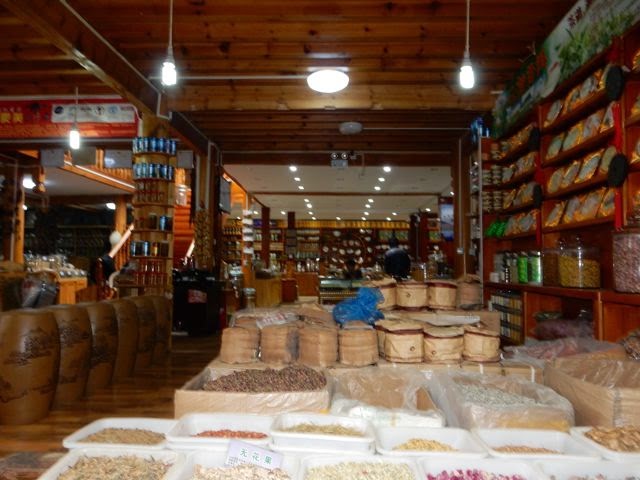 |
| Chinese Apothecary for Teas |
Green tea, suddenly the miracle salve, more benefits than a super-vitamin, now jams up our supermarket refrigerators as cold thirst quenchers and energy boosters, mixed with everything from lemon-grass to mangos. A century ago, it was Coke Cola that for years hid an opiate in its formula, bragging that it was an Intelligent Beverage and Temperance Drink, and contained a valuable brain tonic and nerve stimulant (from the coca plant and cola nuts) and a cure for all nervous affectation. Now green tea with its energy and healing qualities has galloped to the forefront of the health drink craze, overtaking all but beer in America, and requiring no semblance of high ceremony to be performed when consumed. Pop bottle top and swallow. But to really get the benefits of green tea or any tea, it must be prepared and ingested in the traditional ways, with grace and respect, elegance and formality. Dare one ask to have their tea leaves read?
We in the deep south are accustomed to sweet tea, a sugar overload on ice which has few benefits but to satiate thirst and wet the mouth. It is a salve on extremely hot and humid days , a good liquid to wash the barbecue pork down, and I guess, though certainly not healthy with all the sugar, it’s no worse than soda pop. The tea is usually a Lipton product. That’s what we are most familiar with. My Mother made a tasty spiced iced tea which she kept fresh in the icebox and offered her tennis group and us when we stopped in for a visit. As much as I don’t like tea (cold or hot), and cannot touch it or coffee after lunch or I have sleepless nights, I loved mother’s tea and could guzzle a gallon after a tennis match or just smoozing by her swimming pool. Maybe tea is relevant to the moment. And, there are teas made not with tea leaves, but with grasses and herbs like lemon-grass tea and chrysanthemum tea (popular in China).
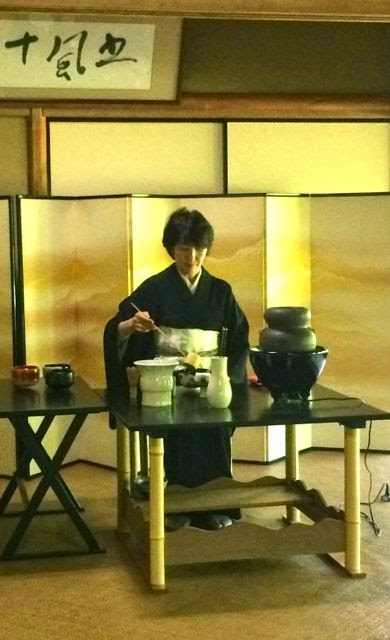 |
| Japanese Tea Ceremony |
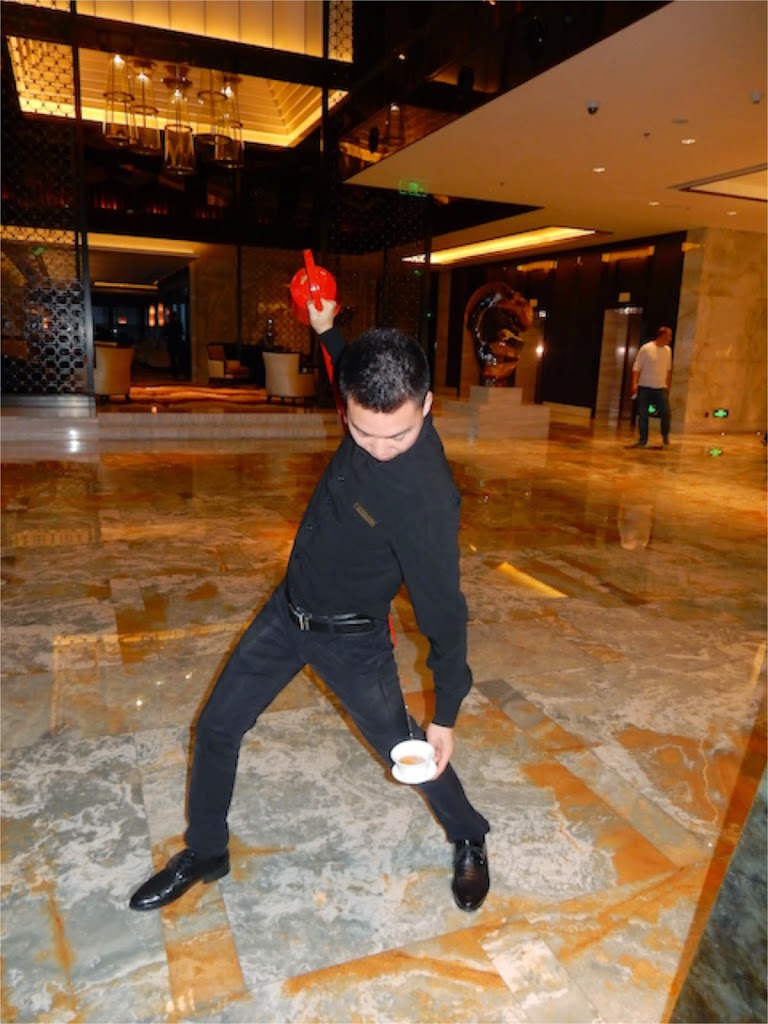 |
| Pouring Welcome Tea |
Tea has not only a suspect, rowdy, raunchy and violent history – remember it was the cause of our own Boston Tea Party tea dump, protesting taxation – but it has always been a vibrant source of life for Asians and East Africans, and today, it appears in every niche of food: green tea energy pills, green tea candies and logenzers, cookies, ice cream – who doesn’t grab for the green tea ice cream after a long night of sushi-sashimi topped with green wasabi. Also in southeast Asia there are green tea cakes and pancakes and mochi and puddings and balms, even. As in most fads in this country, once someone says something is “good for you”, it shows up in every kind of consumption item.
In Britain, and its current and former colonies, and in those countries the Brits moved into historically to build railroads, high tea and tea parties remain somewhat of a tradition. In South America, (Uruguay and Argentina) high tea was a relief so you could make it from lunch at noon til dinner at 10 p.m. And high tea, with those three layered trays, is yet an experience of scones and strawberry jam (they even serve it at Wimbledon Tennis Tournament in England) and small pies and petit fours, tiny sandwiches on thin bread (have you ever tried a watercress sandwich with a slight slap of mayonnaise? No peanut butter here.) and stabs of fruit and fondant cakes from Harrods. In Uruguay, it was a joyful way to experience everyone’s cooking skills and to get together and to fill up on “tortas” usually stuffed with dulce de leche. At my home in Montevideo, I made gooey chocolate chip cookies for tea at a time when chocolate chips did not exist in Uruguay (I brought sample sacks in my luggage in my last days there to encourage the supermarkets to import chocolate chips rather than our having to chop up bars of chocolate in lieu of chips.) Part of my mission, seemingly, was baking chocolate chip cookies not only for tea, but to carry to prisoners.
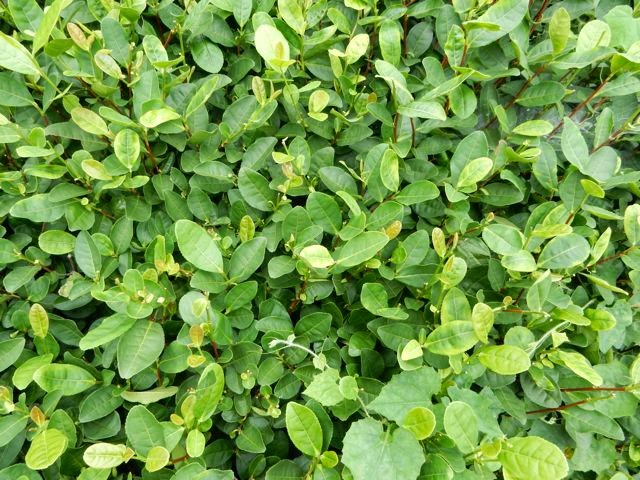 |
| Green Tea to be Picked |
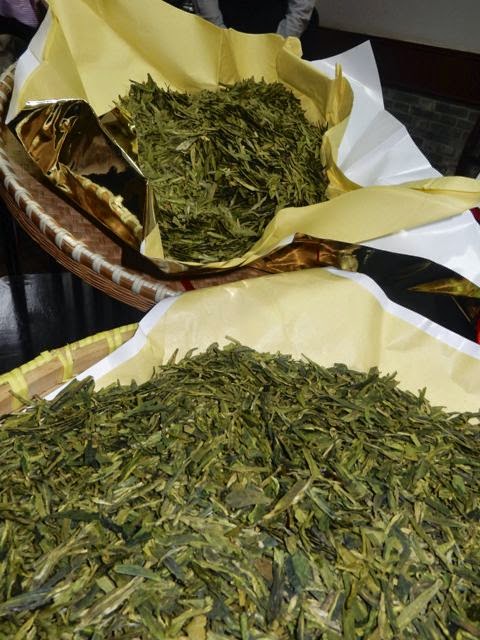 |
| The Best of the Best Tea |
But tea, which is from the camellia family, was what propelled the British ex-pats to nostalgia, while coffee was the drink of the South American nations (where it is grown) along with yerba mate, a tea like leaf of the holly family, which is sipped from gourds through silver spoons as hot water is poured over it from a thermos. Yerba Mate marks an Uruguayan or Argentinian like nothing else and it gives them energy, I think, and some sort of tranquility. Watching families strolling along the “rambla” (sidewalk of the street that borders the ocean) on weekends, kids on bikes or kicking soccer balls, parents sharing and sipping the “mate”, was heart-warming. Families did things together, healthy things, inhaling the rich salt air of the sea.
The point of this is to lead into a sharing of information I learned on my recent trip to China (where green tea was birthed) and Southeast Asia, (where tea is second only to rice as a valuable crop). Tea was the stimulant for much of history in the 19th century, when the greedy European traders forced China imperial rulers to open their doors to an improper, one-sided trade with them. The aggressive colonialists, once they tasted the bitter tea, became addicts to it and no scruple was ignored in order to get what they wanted when they wanted and at what price they wanted. The British, once they discovered tea, would sell their souls to obtain it, sort of like a meth or heroine addict today, although tea was not an illegal opiate. It’s fellow trade item became, though, opium. Tea for opium, opium for tea and that got complicated when silver paid the bill.
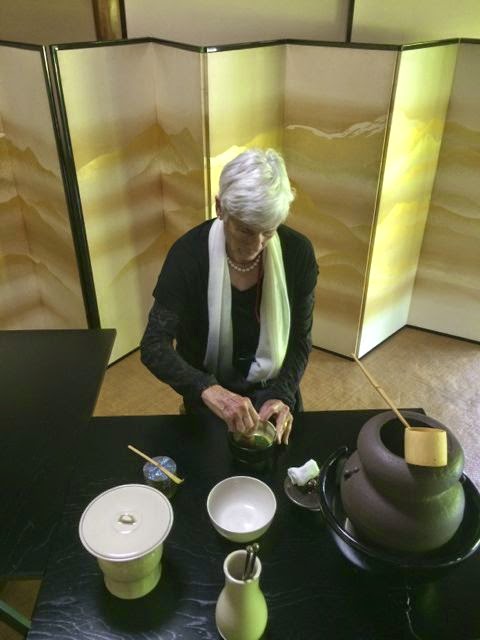 |
| Whipping Green Tea |
 |
| Wash tea over Special Frogs |
The actual origin of tea has never been established but probably appeared in the Shang Dynasty (1750-1100 BC). There are legends, but facts are hard to come by. The plant Camellia sinensis appeared first where northeast India, Burma, China and Tibet came together, but it was considered medicinal not recreational in the beginning. One Chinese claim is that Emperor Shennong, (Fire Emperor or Emperor of Five Grains), originator of Chinese herbal medicine and agriculture, one of three “divine sovereigns” to have ruled ancient China about 5000 years ago, probably discovered tea while experimenting with plants, many of them toxic, to find out how they reacted to the human body. Apparently he was in conference with his subjects in some form of garden where there were the Camellia sinensis shrubs, and as he was drinking a bowl of boiling water – having ordered that all drinking water be boiled – A a green leaf blew into his cup, causing the water to turn green and send out an odor. He took a sip and it made him feel good. With more testing, he realized green tea was an antidote for his battle with poisonous plants. He was also given credit for taking pulse measurements, acupuncture and moxibustion, and is considered the ancestor progenitor of the Han Chinese. He died, supposedly, having tasted the yellow flower of a weed that ruptured his intestines before he could sip his antidotal tea. Later, the philosopher Laozi (dated 600-517 BC), called tea “the froth of the liquid jade”, hence the elixir of life. Not a bad judgement. Today healers say green tea cures cancer and other tricky diseases.
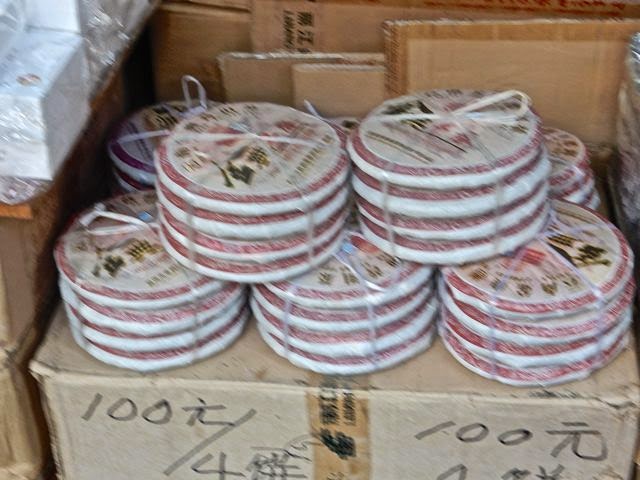 |
| Pu’er Tea from Yunnan Valley |
There were only a few tea plants for centuries, so during the Han Dynasty (202-220 AD), it was limited to use by imperial royalty and the rich. By the Western Zhou Dynasty – tea had become a religious offering. More tea plants were discovered during the Tang Dynasty (618-907) and that is when it sort of was sieved down to the lower classes. Then the government planted tea plantations and actually built tea shops so every class could have a tea time.
It was during the Tang rule that tea spread to Japan – some say through Japanese priests studying in China. It is often associated with Zen Buddhism in Japan because the priests needed to stay awake during meditation. Through Eisai, an abbot of Reisenyi, in 805 A.D. and other Zen Buddhist monks the tea seeds from China were brought to Japan, and Eisai wrote the first book on tea, even though, at that time, tea drinking was limited to the religious classes until the warrior class was given permission to imbibe.
To run through green tea’s development, as tea plantations arose in the Yangtze River Valley, the ceramic trade
 |
| Green tea jelly |
 |
| Green Tea Mochi |
developed (for tea cups and pots), and still, the emperor kept its production a secret. Tea reached the rest of Asia in brick-like block form, vis a vis the great trade routes of horse and camel caravans of the Arabians and Marco Polo, who were transporting salt. For tea to get from China to Russia, for instance, took a year by camel and so it cost a precious price..
During the Tang Dynasty, tea drinkers packed tea in cakes, crumbled off a pinch, boiled in water and flavored with ginger, onion, orange peel, peppermint and served in a wide bowl. In the Song Dynasty, powdered tea was created and was the basis of the Japanese tea ceremony, as it is today. The powdered tea mixed with hot water is beaten rapidly with a bamboo gadget , and that fluffs it up and takes away a lot of the bitterness. (Both my granddaughter and I learned how to prepare tea for this sacred ceremony in Japan in June.) Then in the 13th century tea leaves were roasted and crumbled rather than steamed. There is also a legend that in one village plagued by monkeys, if the villagers made the monkeys angry, they’d run up the tea trees and then begin tossing the leaves down on them. This is called “Monkey picked tea”.
In the Ming Dynasty, the tea pot was first used as was loose tea leaves, because only that style would suit as a gift to the emperor. Tea was then served in tiny cups to enhance its fragrance. The smallest cup of tea I experienced in China was at Namu’s Restaurant in Linjing where the glass cup, like a small balloon, had a diameter smaller than my little finger. Just a couple of sips, that was.
In the last of the Dynasties, the Qing’s (1644-1912), tea was no longer unique to China. The British and Western traders had battered down China’s imperial doors and forced it into trade so the addicts of its population could have all the tea in China for all the opium it could find. First teas, only green tea, were brought to Europe in the 1600s. It’s stringent flavor was satiated by honey but soon the sugar cane trade grew in the colonies and the British imported tons and tons of sugar from the Americas to supplement their tea craze. Meanwhile Highland Asians, Mongolians and Tibetans mixed tea with milk or yak butter to supplement their cold climate diets. Butter tea kept them warm and gave them energy.
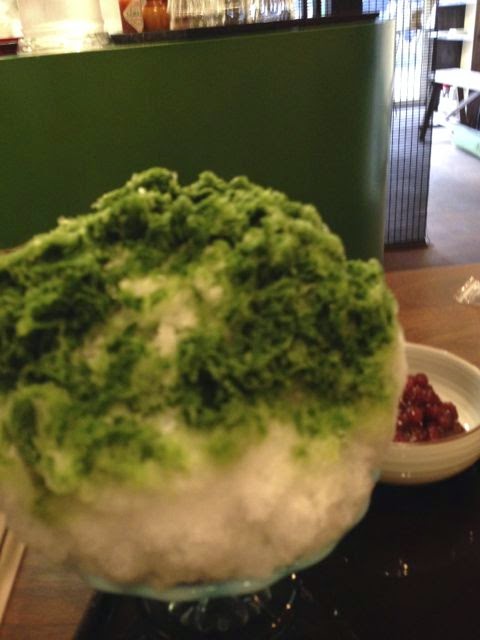 |
| Green Tea Shaved Icecream |
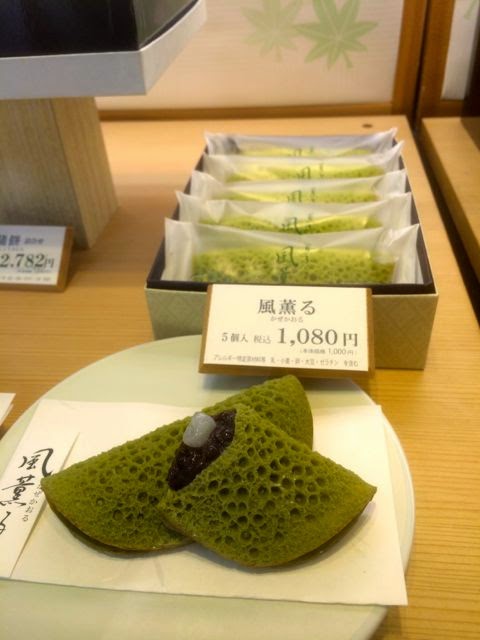 |
| Green Tea Sponge |
In the Qing dynasty, the emperor decreed that “China was the center of the world and had everything they could ever need, so all trade with foreigners must be paid for in silver” (you should see the silver ornamentation of women in the hill tribes.) This meant British had to pay for its tea with silver bullion, dipping into the British wealth almost too deeply. But Britain exported opium from the traditional growing regions of India (where it is stilled grown legally but this originally was in the zone of what is Afghanistan and Pakistan today). Opium use in China was not new, but British importation of opium (beginning in the late 18th c), increased five fold in 16 years as addiction exploded in China. Because tea was overtaxed by the British empire and the ban on opium trade created a funding problem for tea importers, this led up to the First Opium War which was an embarrassment for China. British smuggled tea plants out of China, and created plantations in Darjeeling, Assam in India and Ceylon so they didn’t have to depend on Chinese tea. And, yes, tea was responsible for Britain’s global domination in the trade world and it still seems a reminder of their colonialism and domination efforts all over the world.
In Britain, over 90 per cent of the tea is black tea, usually served with milk and sugar and it’s packed in a tea bag, which is a travesty to most people in Asia who would never degrade tea in that way. The tea in tea bags, like it or not, I was told many times, are the broken leaves, the lesser grade, the easier to harvest. Since the British made India their garden of tea, from Assam to Darjeeling, and the East Indian Trading Company monopoly over Chinese trade in 1838 helped free tea trade and tea growing in India, three types of tea developed: 1) green tea, unfermented, after plucking to prevent oxidation and preserve color, was often scented with jasmine or chrysanthemums; 2) Oolong Tea, semi-fermented leaves withered in the shade for 5 hours then pan fried ten minutes, rolled, twisted and oxidized to deter color. Fermented leaves are reheated in an hourglass shaped basket where it stays up to three hours to stop oxidation. Then it is pan fried again on low heat for up to twelve hours before being packed to ship. 3) Black teas are fermented leaves, withered up to 24 hours, then rolled, sifted and spread out on spotless surfaces for a couple of hours to oxidize, then dried by hot air in a machine and sorted by size and grade of tea.
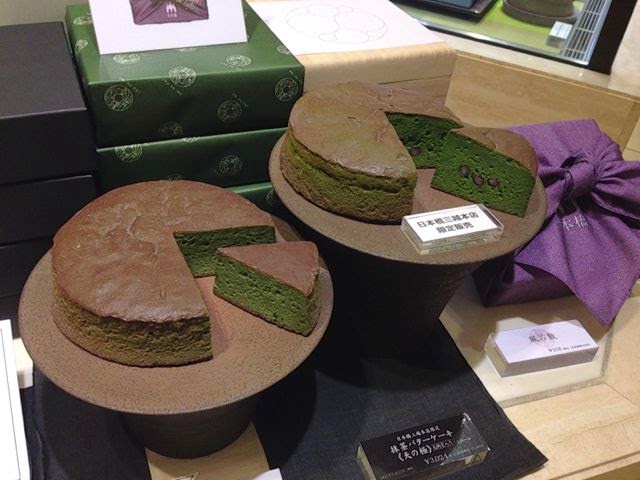 |
| Green Tea Torte |
 |
| Fancy Tea Thermos |
In the 17th century when King Charles II married the Portuguese princess, Catherine of Braganza, she turned the masculine love of passing the day in tea houses mixing business with tea drinking , into a social event appropriate for royal ladies, but in private homes. Because of Catherine, it is said, the East India Trading Co. ‘s profits soared and the British government taxed tea so high that smugglers wheeled and dealed tea leaves to those who could not afford it. So happened our Boston Tea Party. In addition, Australian Aboriginals drank tea picked from the leptospermum plants, now known as ti tree. And eventually, as the British planted tea plantations in their colonial Kenya (next to coffee), business has so thrived that it is the largest exporter of tea to Britain today.
On my recent trip to China, I visited the Longing/Dragonwell tea plantation, where the highest quality of green tea is handpicked and can cost up to a thousand dollars a kilo. Pu-er tea is another very high priced tea from Yunnan Province in China and is considered the finest tea in China. It is packed the old fashion way in blocks. Lotus tea from Vietnam is fascinating high-priced drink, because the green tea leaves are picked and put into lotus flowers between their petals overnight to absorb the exotic scent of the Lotus. It is supposed to be superb for your health and good on auspicious occasions. It cost $350 a kilo. Most green tea addicts carry a thermos filled with fresh tea leaves over which hot (not boiling) water is poured, and can be re-enforced during the day. These thermos are in the world of fancy – a solid silver one or one covered in crystals or engraved with dragons. But if you don’t have time to deal with making and carrying tea, there are tea tablets (tiny things) which you can pop during the day to reduce the anti-oxidants in your systems. These are easier for those who don’t like to drink green tea all day long as advised by tea growers and Chinese herbalists.
